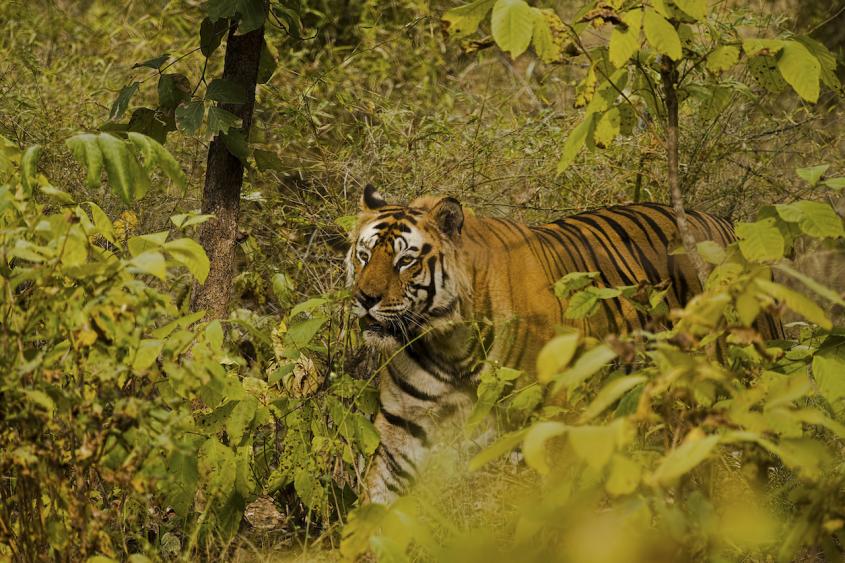The truth about cats and dogs: Canine distemper in big cats in Nepal
Tiger in Jungle_D805114 (R. Gilbert).jpg

A Bengal tiger walking through the jungle. Although researchers have suspected distemper was infecting tigers and leopards, a new study is the first definitive proof of infection in Nepal’s big cats. Photo: R. Gilbert
Researchers with the Cornell University College of Veterinary Medicine have confirmed the first cases of canine distemper virus (CDV) in tigers and leopards in Nepal. This is significant, as both populations are already threatened and the virus can cause fatal neurological disease.
“Canine distemper virus has been repeatedly identified as a threat to wild carnivores and their conservation,” says Dr. Martin Gilbert, Cornell Wildlife Health Center wild carnivore health specialist and associate professor of practice in the Department of Population Medicine and Diagnostic Sciences. “This study is a first step to understanding the potential impact for Nepalese tiger and leopard populations.”
Although researchers have suspected distemper was infecting these species, the study, published Jan 28 in the journal Pathogens, is the first definitive proof of infection in Nepal’s big cats. The survey found 11% of tigers (3/28) and 30% of the leopards (6/20) had antibodies to CDV (indicating prior infection with the virus).
Leopards and tigers and dogs — oh my!
Relatively little is known about the status of Nepal’s leopards, but scientists believe the population is in decline due to a combination of poaching, habitat loss and human-wildlife conflict. Leopards also face increasing competition for space due to the expansion of the country’s tiger population. Could CDV push them even further into decline?
Unlike their spotted cousins, “Tigers are enjoying a resurgence in Nepal,” says Gilbert. “Their national population has almost tripled in size over the past 12 years — however, globally the species remains endangered.” As the larger and stronger of the two species, tigers have been displacing leopards from national parks and forcing them into areas with more people, where they often prey on street dogs.
Based on the findings of this paper, these dogs may be the source of infection. “We already know CDV is circulating in the Nepali dog population,” says Dr. Jessica Bodgener, a veterinarian with Wildlife Vets International, who co-authored the paper, “and that leopards frequently eat dogs, while tigers do not. When we found a greater exposure in leopards it seemed like a good fit, but we need more evidence to be sure. And we can’t forget three tigers also tested positive. If tigers aren’t eating dogs, it raises the question, how did these animals get infected? The situation may not be straightforward.” Other species that could be acting as reservoirs include wild carnivores like jackals and civets.
The team examined blood samples collected from tigers and leopards between 2011 and 2021 by veterinarians working for Nepal’s Department of National Parks and Wildlife Conservation and the National Trust for Nature Conservation (NTNC). These were opportunistic samples, with most of the captures occurring as part of routine wildlife management. Routine collection and archiving of samples like these can prove invaluable when it comes to investigating disease.
In many places, CDV surveillance is hampered by a lack of local laboratories set up to run the appropriate tests. Access to specialist international labs can be blocked by export bans or slowed by permit application processes. To sidestep these issues, Gilbert’s team chose not to export the samples, but to partner with the Agricultural and Forestry University in Chitwan, to establish testing in Nepal, something they hope to see replicated elsewhere. “Establishing national testing facilities that can support coordinated CDV research and surveillance efforts is both highly desirable and achievable, and should lead to increased sampling and collaboration,” says Gilbert.
Action steps
With the presence of the virus confirmed in these populations, the priority now is to understand the threat CDV poses to their survival. The research team recommends several immediate actions:
- Wildlife managers should be made aware of the threat posed by CDV to leopards and tigers and encouraged to report cases of big cats showing signs of neurological disease.
- Testing of leopards and tigers should be expanded to include molecular testing and genetic sequencing, as well as continued monitoring of antibodies.
- To inform appropriate control measures, such as vaccinating dogs, or potentially the big cats themselves, researchers should confirm which animals are acting as reservoirs for CDV.
- Because small, isolated populations are most at risk, efforts should be made to increase habitat connectivity through wildlife corridors.
“Since 2014, we have seen 10 leopards showing neurological disease that could be consistent with CDV infection,” says Dr. Amir Sadaula, NTNC veterinarian, who led the Nepali research team. “With increased awareness, we plan to confirm future cases and obtain genetic sequences to help determine the source of infections.”
Looking to the future, Gilbert and his team plan to continue their work in Nepal, particularly on the under-studied leopard. Research is already underway to introduce more comprehensive big cat health assessments in a bid to understand the potential roles of injury and disease in increasing the likelihood of conflicts with people. Meanwhile, ongoing ecological fieldwork is investigating how the predation of domestic dogs may be influencing the behavior and distribution of leopards outside of national parks.
The study was made possible through generous support from the Cornell Feline Health Center, Cornell Wildlife Health Center, Wildlife Vets International and two anonymous donors.
The Cornell Wildlife Health Center strives to sustain a healthier world by developing and implementing proactive, science-based solutions to challenges at the interface of wildlife health, domestic animal health, human health and livelihoods, and the environment that supports us all.
Written by Lauren Cahoon Roberts




